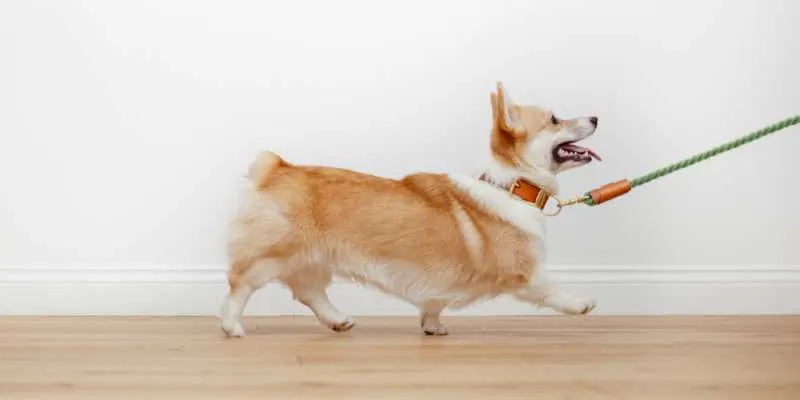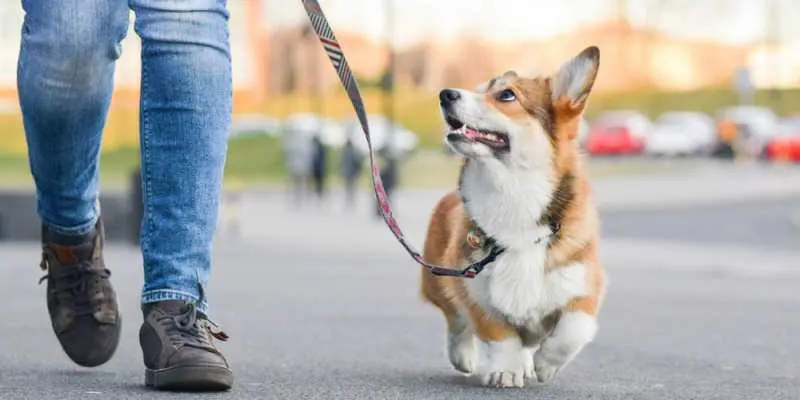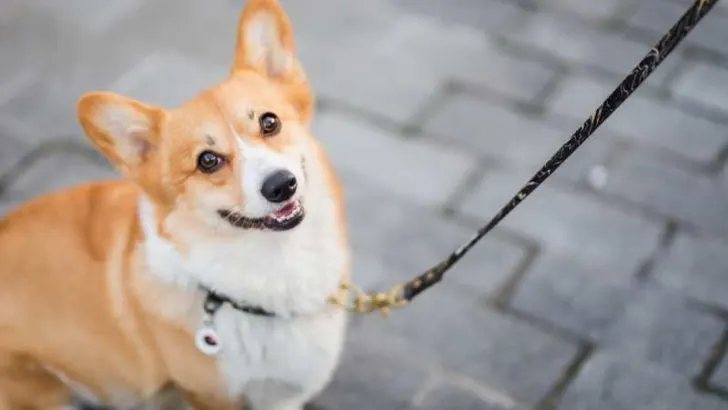We all love our Corgis, and we go to great efforts to make sure our Corgis have everything they need to stay healthy and happy. From feeding to finding the best toys, we’re always looking for ways to give them the best.
One thing that you shouldn’t overlook here is selecting the right leash that will work well for training your Corgi. So, the question arises: How to leash train a Corgi?
Corgis are small – but they can sure be strong. If you don’t take time to properly train your furry friend to walk nicely on a leash, it could end up walking you!
If you want to know how to train a Corgi to walk on a leash, be sure to read this article, as we’ve covered everything you need to know.

Training A Corgi To Walk On A Leash
Although it seems like walking on a leash is something that comes naturally to dogs, it most certainly isn’t. Even the most disciplined of dogs will need to be trained once on the leash.
Going for a walk outside is pretty different from an afternoon trip to the backyard to “do the business.”
Your Corgi will require patience and time so it can learn how to walk on a leash. Without proper training, even the obedient Corgi will start to pull.
A dog that’s pulling could put both you and itself in danger.
It’s crucial to start with training while your Corgi is still young. Puppies respond much more effectively to training than fully grown canines who are set in their ways.
Your Corgi should walk loosely on the leash and at your side – rather than pulling on the leash and straining to get ahead of you. Your Corgi should realize that you’re the pack leader and in charge here.
Get your Corgi used to a collar and leash before attempting to walk them. Let your Corgi drag the leash around attached to the collar. You want your Corgi to be comfortable with the leash rather than afraid or annoyed by it.
Make sure you have short training lessons in familiar places. Your puppy most likely has a short attention span, so don’t expect to keep its interest in training for more extended periods.
Start with walking around the house or backyard as these places are filled with smells familiar to your Corgi. By doing so, your Corgi won’t be as inclined to break off in all directions to smell exciting new odors.
More importantly, be sure to praise good behavior.
When your canine friend walks alongside you on a loose leash, reward them with an occasional treat.
It would be best not to pull your Corgi along. If they don’t want to leave a spot, pulling on the lead can potentially injure him.
So, focus on rewarding your Corgi for coming when you call them to keep walking along. If your Corgi is persistent, you might have to redirect their attention to the walk – and away from the thing that they’re focused on at the moment.
While keeping a short leash is something we humans see as unfavorable, keeping your Corgi on a short leash is essential to leash training success.
The less room your Corgi has to stray away from you, the easier it is for them to learn to walk next to you.
Similarly, walking with your Corgi at your side – instead of in front – allows you to control your dog’s direction. When dogs are allowed to walk behind or in front, they tend to wander off.
Plus, keeping your Corgi at your side will prevent the leash from becoming tangled.
You can start to be more forgiving with your Corgi as they become more trained. However, it’s best to keep your dog close while still a puppy.
And again:
Remember that dogs are pack animals. If your Corgi sees you as a pack leader, they will fall in line and become the best walking partner you ever had.
Don’t forget to give your Corgi some time to do their business. For many dogs, a long walk is a chance for them to relieve themselves. But dogs love to mark their territory, so they might want to sniff around to find the perfect spot.
If you notice that your Corgi needs to relieve himself, stop walking and extend the leash a bit to allow them to search the right spot and do their business.
Keep in mind that dogs don’t always empty their bladder at once. Your Corgi might look for several sports to urinate during the walk.
And while we’re on the subject:
It’s vital to reward your pup if they do their business the first time around. Otherwise, your dog will start to develop positive relations with marking multiple times, which would make it much more difficult to walk.
When your Corgi understands that they only have one chance to relieve themselves, they will start to walk much better.
In the end, dogs are curious, so they tend to rush to specific spots on your walk. It’s vital to pick a pace that’s comfortable for you – as well as for your Corgi – and stick to it. You don’t want your dog to pull or lag, as this can lead to injuries.
If you see your Corgi struggling to keep up, stop and wait for them to come back to you. Then, re-establish a comfortable pace.
Read More: Can Corgis Walk Off Leash? Can Corgis Walk Far?

Choose The Right Leash & Collar (Or Harness)
There are a lot of different types of leashes, collars, and harnesses on the market.
How do you know which one to choose to leash train your Corgi?
Neck collars are a typical choice and a fine for dogs that aren’t inclined to pull. Harnesses have become popular in recent years and are considered an excellent tool in leash training dogs in general.
That’s because a harness won’t injure your dog’s neck or windpipe if they pull. Also, harnesses are less likely to get tangled as the leash attaches to their back rather than their neck.
Surprisingly, you can find plenty of leash choices, including retractable, adjustable, chain, and multiple dog leashes.
Some trainers prefer a slip leash to train a puppy to heel because it gives the walker more control than a standard leash. However, a harness or head halter is a better choice if your Corgi pulls since it won’t hurt or choke them.
Most importantly, be sure to choose a leash that’s appropriate for your Corgi.
A leash that’s too large can add unnecessary weight to your Corgi. And a leash that’s too small could spell disaster for you if your dog spots something they want to investigate.
See Also: Do Corgis Need A Harness? Are Harnesses Bad For Corgis?
Preventing Unwanted Behaviors
Dogs can have a range of bad habits on walks. One of the most common habits is pulling.
If your Corgi pulls, give them less slack on the leash. The more leash length your dog has, the more approval they think they have to explore.
Additionally, if your Corgi pulls, stop walking and use verbal cues like “No pulling” or “Oops.” After that, wait for a loose leash before you continue going forward.
Don’t forget to use treats and positive reinforcement when your Corgi is behaving correctly.
If you notice your Corgi is pulling for a specific reason – like other dogs, wildlife, or strangers – it might be a good idea to walk in another direction or wait until the discovery has passed.
You want to avoid letting your dog think that pulling is okay – or even worse, injuring them.
If you allow your Corgi to pull and try to walk faster to keep up with them, you’re instructing your dog that all they have to do is speed up to get to the thing more quickly. And that can turn a nice walk into a sprint!
Walking With Your Pack
While your Corgi is still leash trained, we advise you to walk them alone – even if you have more dogs at home. Having more than one dog around can be quite distracting as well as dangerous.
Until you know your Corgi is trained and are familiar with their moods and temperament, you should walk them by themselves.
Once you think your Corgi is ready, you can try walking multiple dogs simultaneously by adding a “coupler” to separate leashes to reduce tangling.
Walking At Night
It’s very likely that you’ll have to walk your Corgi at night at some point. It’s even more essential to follow leash training tips when walking your Corgi at night.
That’s because your dog is more likely to pick up on stuff you can’t see.
You want to avoid them pulling and yanking the leash out of your hands, making it very difficult to find them in the dark. Make sure you keep your Corgi close and walk in well-lit areas.
Learn More: Are Corgis Good Off Leash?

Bottom Line
If you are uncertain about “how to leash train a Corgi,” let us break it down for you real quick:
Start leash training when your Corgi is still young. It’s a good idea to start by walking your Corgi around familiar places – and don’t forget to praise good behavior.
Keeping your Corgi on a short leash is crucial in leash training.
Make sure you purchase the correct leash and collar – or harness – for your Corgi. There are plenty of different leash choices on the market, such as retractable, chain, and adjustable.
If your Corgi is pulling a lot, we advise you get the harness since it won’t choke or injure the dog.
In addition, if your Corgi pulls while walking, be sure to stop and give a vocal cue. Please don’t allow your pup to pull; the dog will assume it’s acceptable behavior.
Having more dogs can be distracting. So, make sure you walk your Corgi alone until you’re confident that they are trained.

